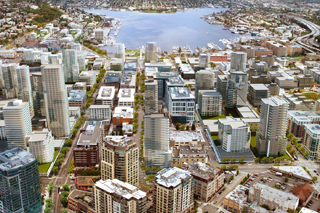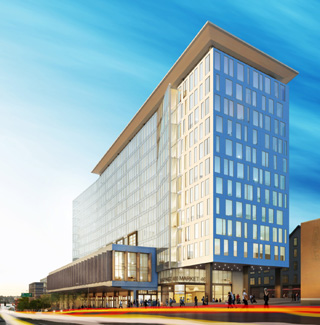|
Subscribe / Renew |
|
|
Contact Us |
|
| ► Subscribe to our Free Weekly Newsletter | |
| home | Welcome, sign in or click here to subscribe. | login |
Real Estate
| |
May 13, 2013
After the rezone: What's next for South Lake Union?
Journal Staff Reporter
It's official: Taller buildings are allowed in South Lake Union, and developers who have been waiting for the rezone can move forward with their projects.
According to documents from the Seattle Department of Planning and Development, there are nine projects in the pipeline that were waiting on the council vote, with a total of 976 housing units, 1.98 million square feet of office space and a hotel.
Four developers have applied for master use permits, which is the primary permit needed on a project.
The projects are: Skanska USA's 400 Fairview, a 13-story, 301,000-square-foot office building above 30,000 square feet of retail; Touchstone Corp.'s 13- and 12-story buildings at 307 Fairview Ave. N., with more than 800,000 square feet of office space; Equity Residential's two seven-story, half-block apartment buildings at 222 Fairview Ave. N. with a total of 497 units; and Greystar Real Estate's seven-story, 279-unit apartment complex at 400 Boren Ave. N.
Here's a look at the other projects in the pipeline:
• Vulcan has several office project proposals for Ninth Avenue. Two projects, at 325 and 400 Ninth Ave. N, would be 12 stories, with a total of 600,000 square feet of office space. Graphite Design Group is the architect on the 325 Ninth project and NBBJ is designing the project at 400 Ninth. According to city documents, those projects had their first early design guidance meetings earlier this year.
Vulcan has also approached the city about developing two 195,000-square-foot office buildings at 330 and 333 Eighth Ave. N.
These proposals are in addition to Vulcan's new space for Amazon.com, which is under construction on two sites: 500 Ninth Ave. N. and 515 Westlake Ave. N. and will not take advantage of the rezone. Completion is expected in 2015. ZGF is the architect.
• Walsh Construction proposed one 11-story tower and one 12-story tower at 501 Fairview Ave. N. They would have 275,000 square feet of office space, and 9,800 square feet of retail. An early design guidance meeting was held last June, and no master use permit application has been submitted, according to city documents. Weinstein AU is the architect.
• The Wolff Co. is planning an eight-story, 200-unit building at 430 Eighth Ave. N. that also will have 13,000 square feet of retail. Miller Hull is the architect. An early design guidance meeting is scheduled May 22.
• Stanford Hotels is planning a 15-story, 283-room hotel at 300 Terry Ave. N., the site of Bio-Rad Laboratories. Two early design guidance meetings have been held for this building. Jensen Fey Architecture and Planning will design the project.
Lisa Picard, executive vice president at Skanska's Seattle office, wants 400 Fairview to be the first office building out of the ground. She said the goal is to start construction this year and have space ready in early 2015.
Skanska is making some changes to the design now, tweaking the color schemes and materials.
Picard said her company was not worried the rezone would fail, but it was prepared to seek a text amendment to rezone individual parcels just in case it didn't pass.
“We had been assuming we would get the approval, and now it has gone through,” she said.
While 400 Fairview has no anchor tenant yet, Picard said a lot of leases are coming up between 2014 and 2016, and those tenants may already be looking.
Under the new zoning, Greystar Real Estate's 400 Boren apartment project could go up to 240 feet if the developer paid into the incentive zoning program or built low-income units on site.
Representatives of Greystar did not return a call requesting comment.
A report prepared by Via Architecture last year identified 33 locations where high-rise towers could be built in the neighborhood: 17 of them were likely to be housing and 16 of them would be office space.
So far, no developers have applied to build apartment complexes that reach the top limits of 160 and 240 feet.
Vulcan may change that. During the rezone discussions, Vulcan showed renderings of three skinny 240-foot residential towers on the Mercer Blocks, across the street from Lake Union Park. Vulcan planned to convey ownership of half an acre bounded by Mercer, Republican, Aurora and Dexter — known as Block 59 — in exchange for a 240-foot height limit on the Mercer Blocks.
That proposal was shelved, and the City Council decided to limit residential towers to 160 feet on those blocks. Vulcan filed applications to build small warehouses on the blocks earlier this year because of a deadline that was part of the deal when the company bought the land in 2002. Vulcan can revise the permits later if it decides to build 160-foot towers.
One of the most controversial decisions involving the rezone came when the City Council raised the fee developers have to pay if they don't build low-income units as part of their high-rise projects. The fee went up from Mayor Mike McGinn's proposal of $15.15 to $21.68.
Lori Mason Curran, real estate investment strategy director at Vulcan, said last week that some developers may decide not to build to the full height because of the increased cost.
She suggested The Wolff Co.'s project could be an example. Originally, Wolff Co. planned a 17-story tower but later reduced it to an eight-story building. Representatives from that company did not return a call requesting comment.
Matt Griffin of Pine Street Group said he left extra height on the table with his high-profile downtown apartment tower Via6. Griffin said the cost of going to the maximum height — 400 feet — outweighed the benefits.
The 240-foot project has two 24-story towers, and Griffin said 375 of the 654 units have been leased.
As buildings get taller so do the construction costs for each foot of space. In addition to those costs, Pine Street would have had to pay incentive zoning fees if it had gone up to 400 feet.
Seven-story buildings, like the ones Greystar and Equity are planning, cost less to build. Crews don't need to use as much concrete and steel, and most of the building can be wood.
Combine those costs with the number of other apartments recently opened or coming to South Lake Union, and a seven-story building is a much safer investment than a 160-foot building.
Building taller means more risk, Griffin said. “Everyone has to decide what their tolerance is for risk when they look into the future and see more competition, not less.”




